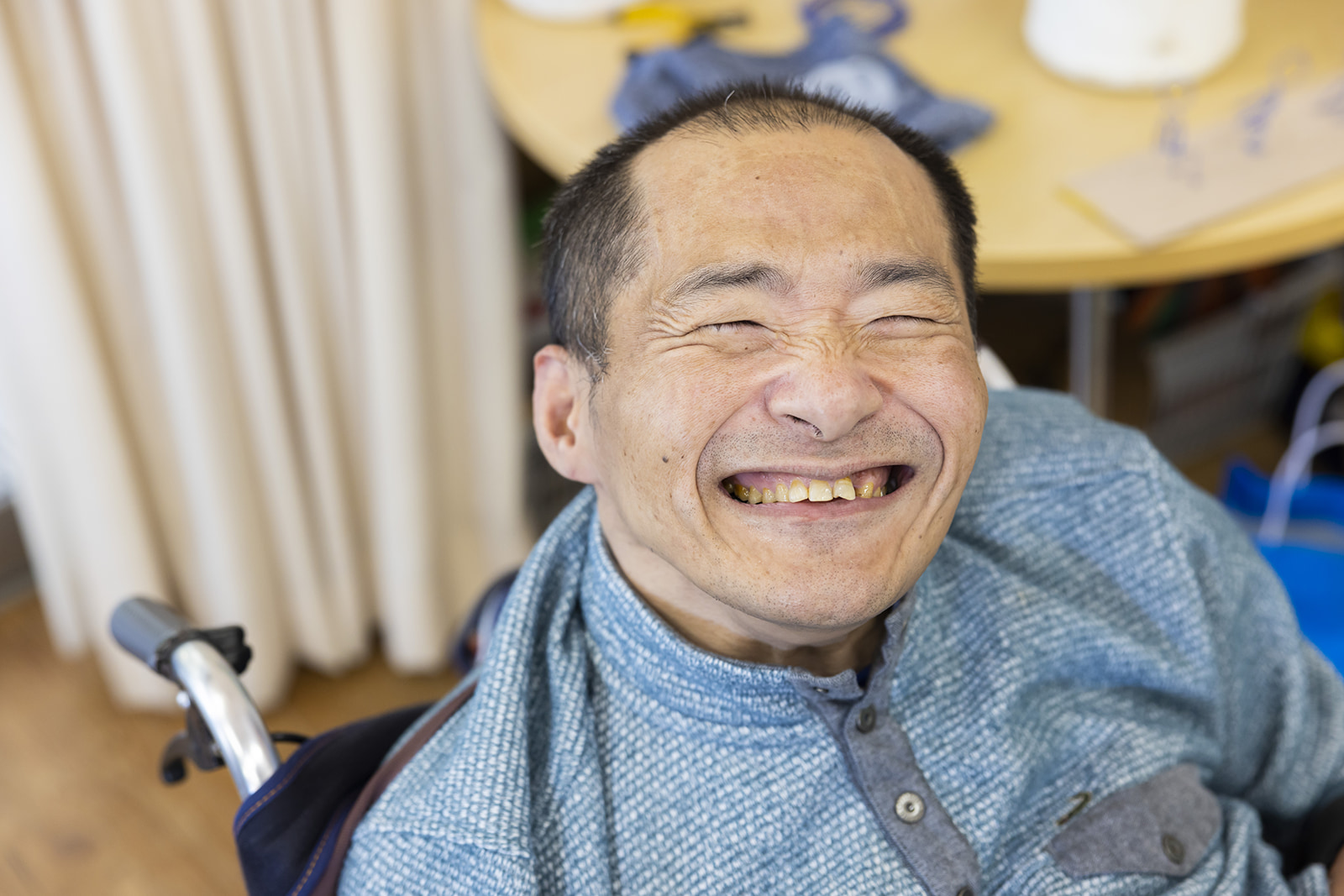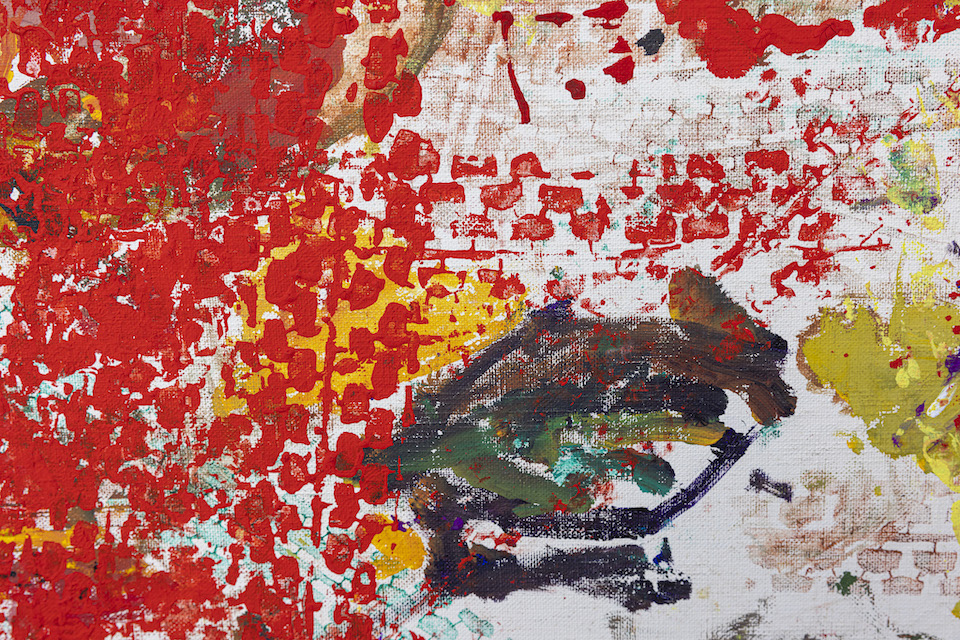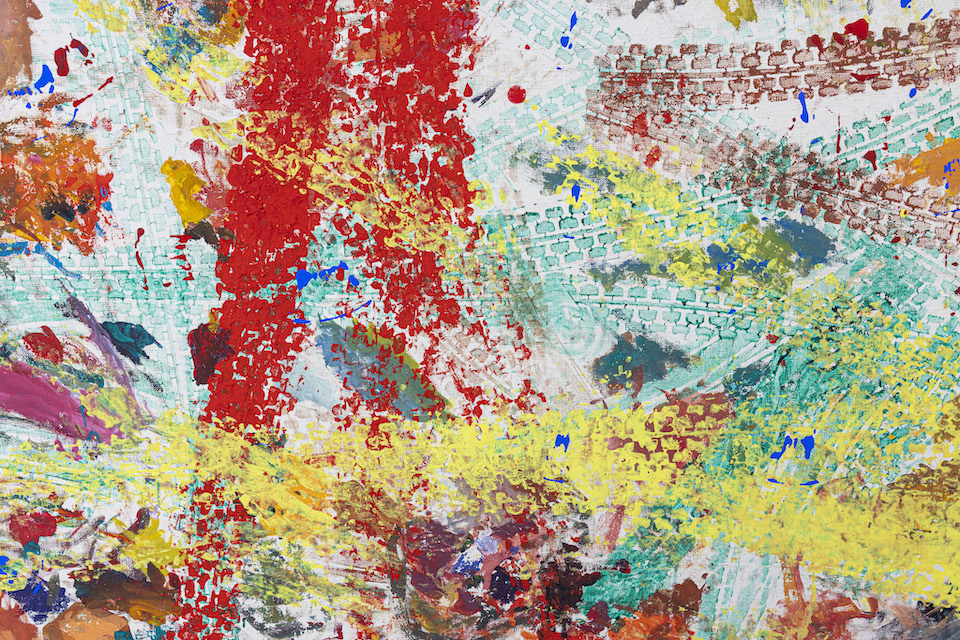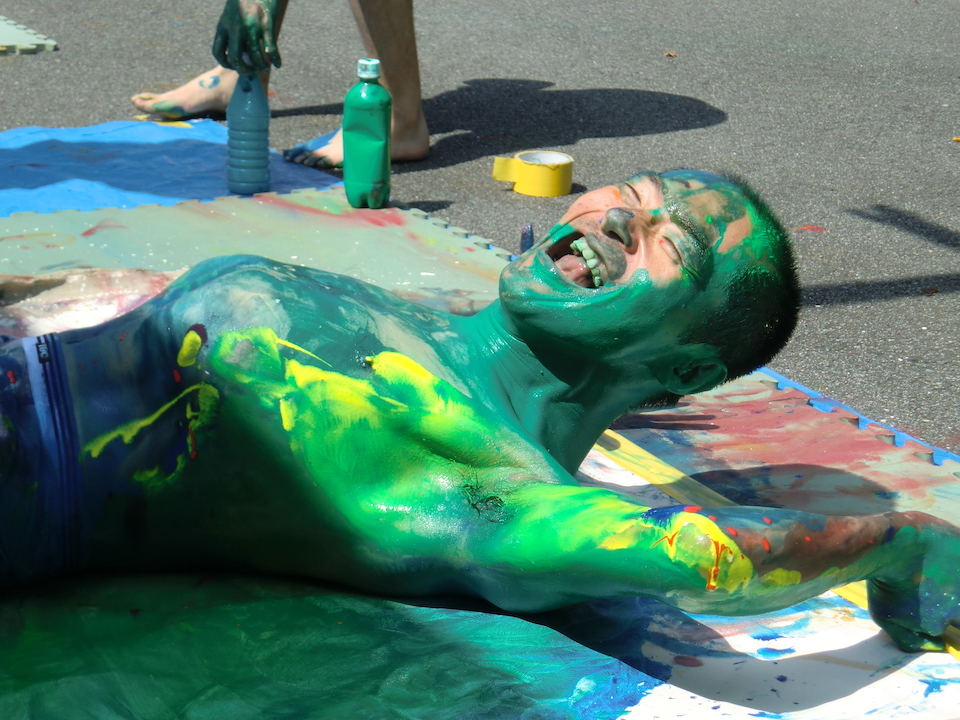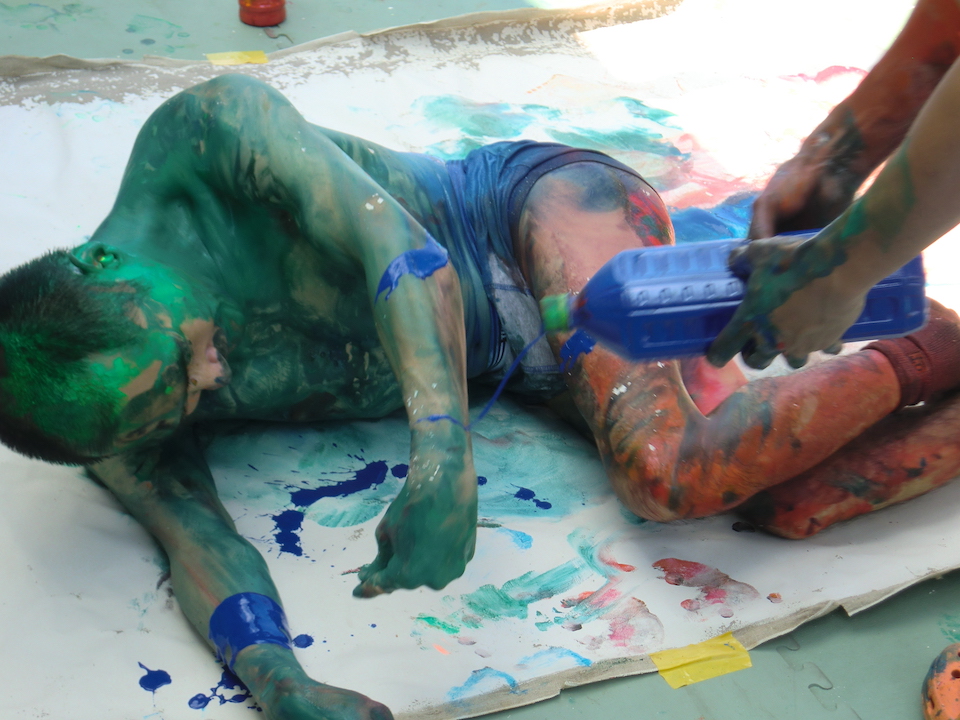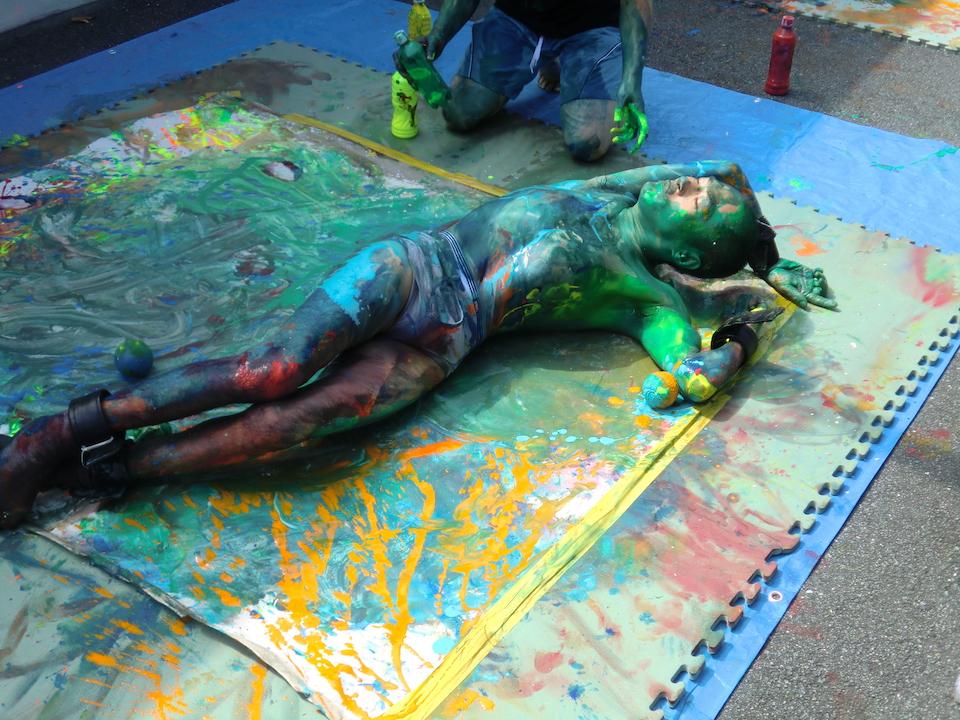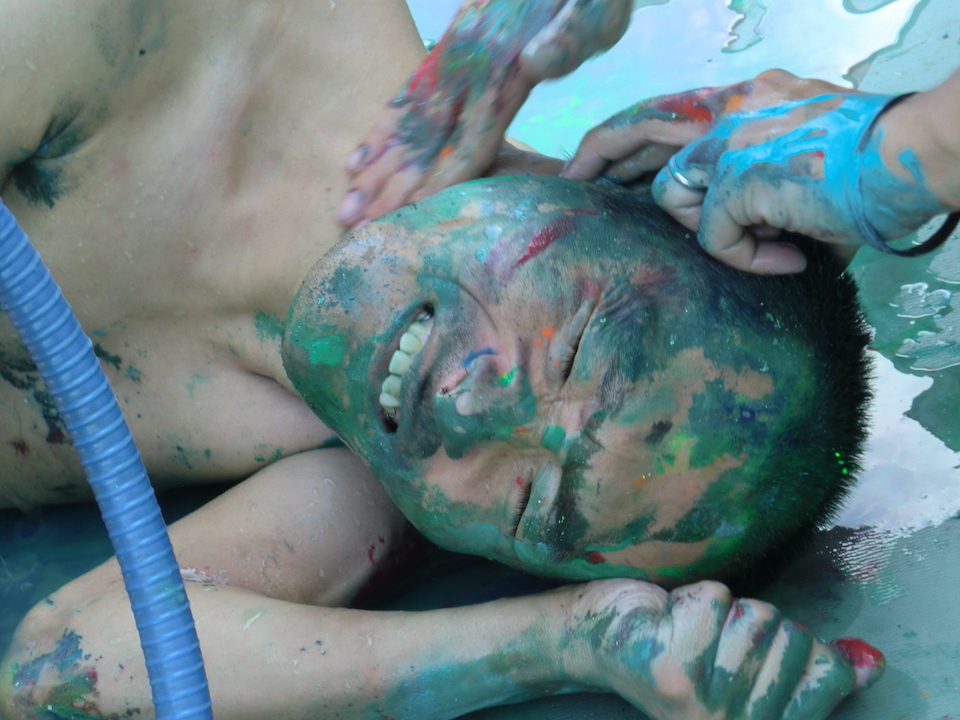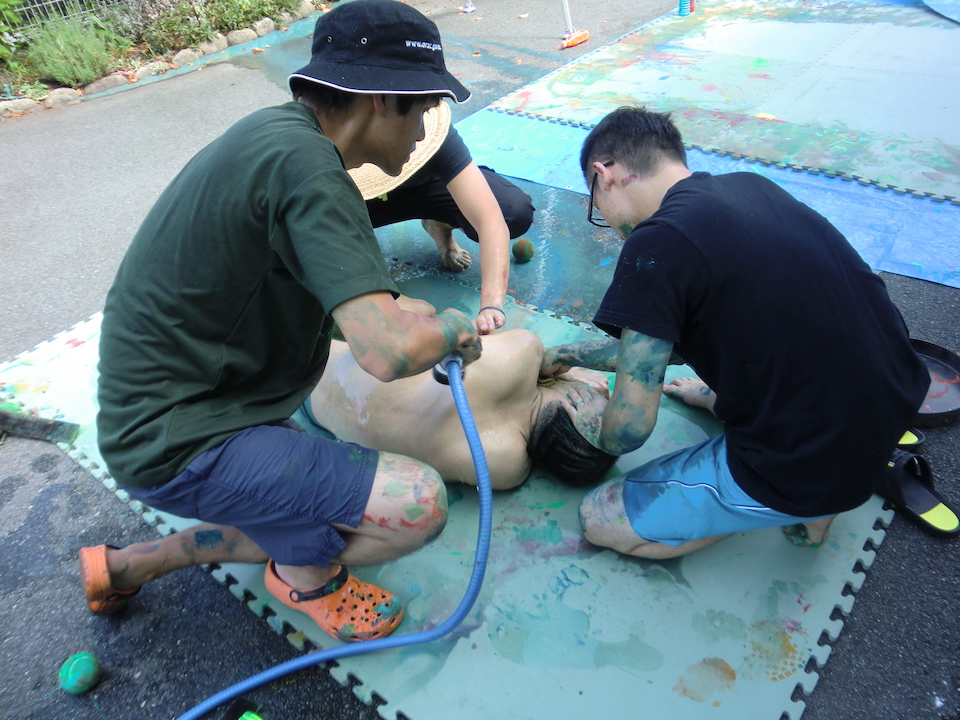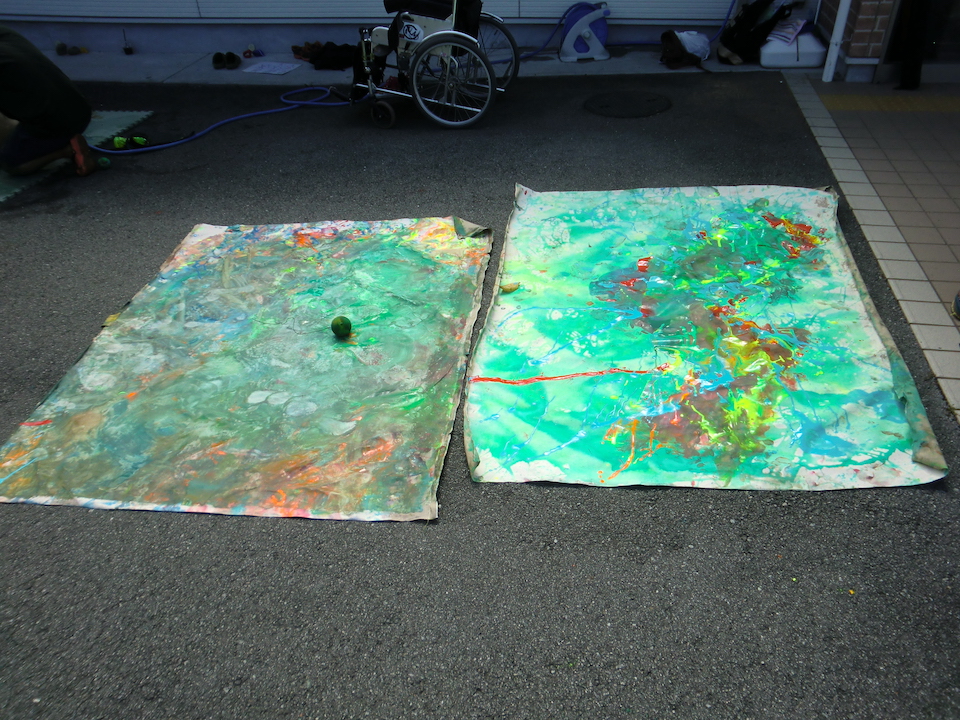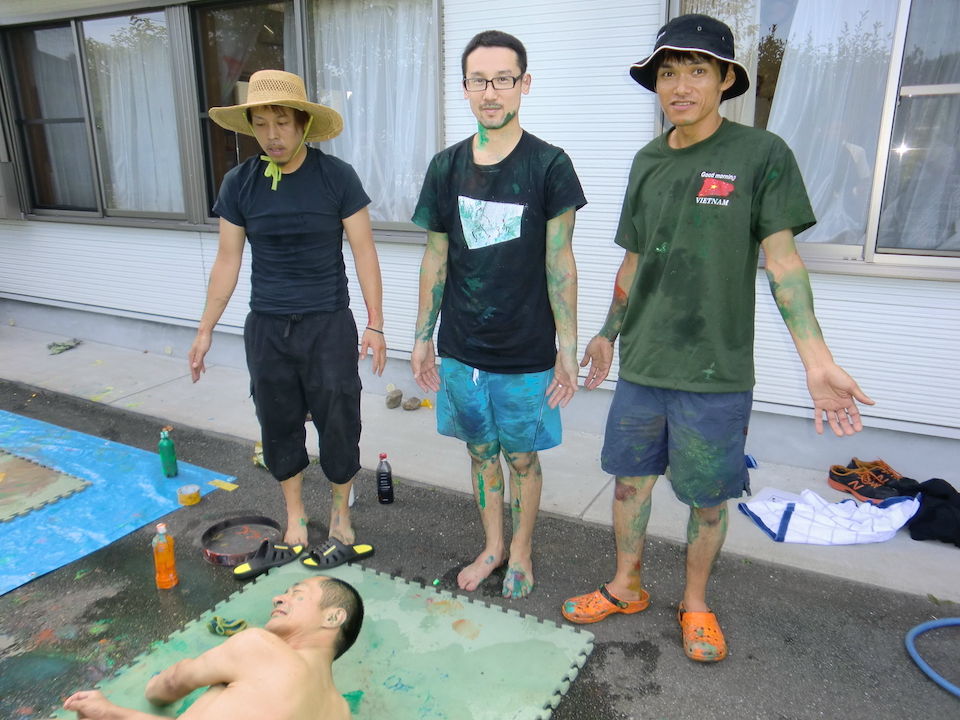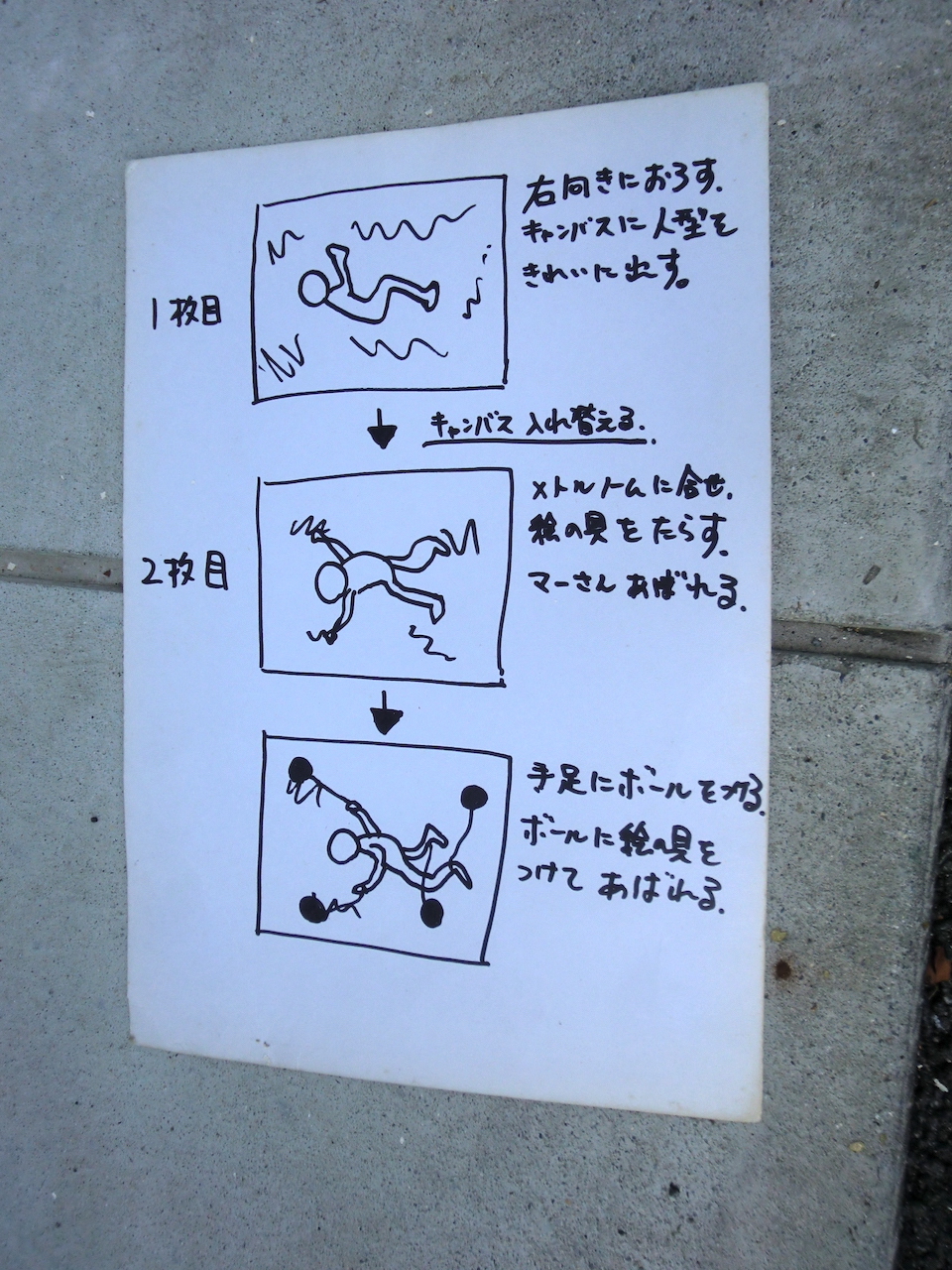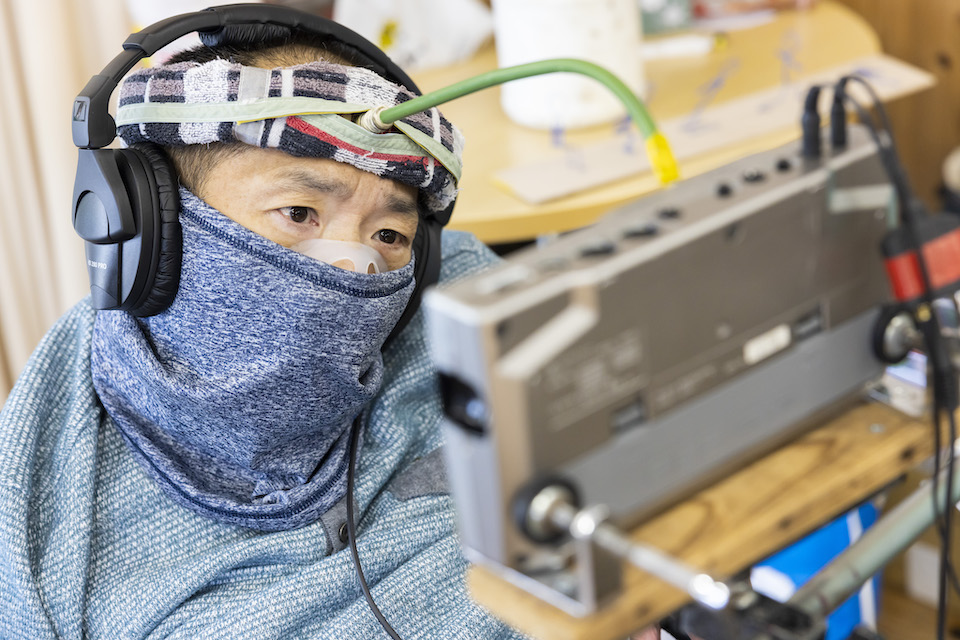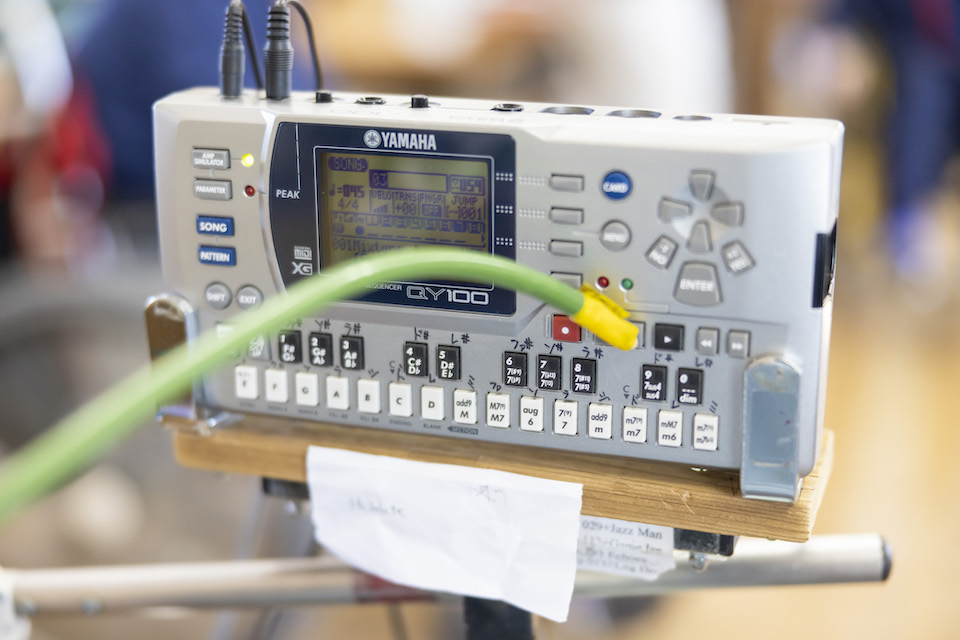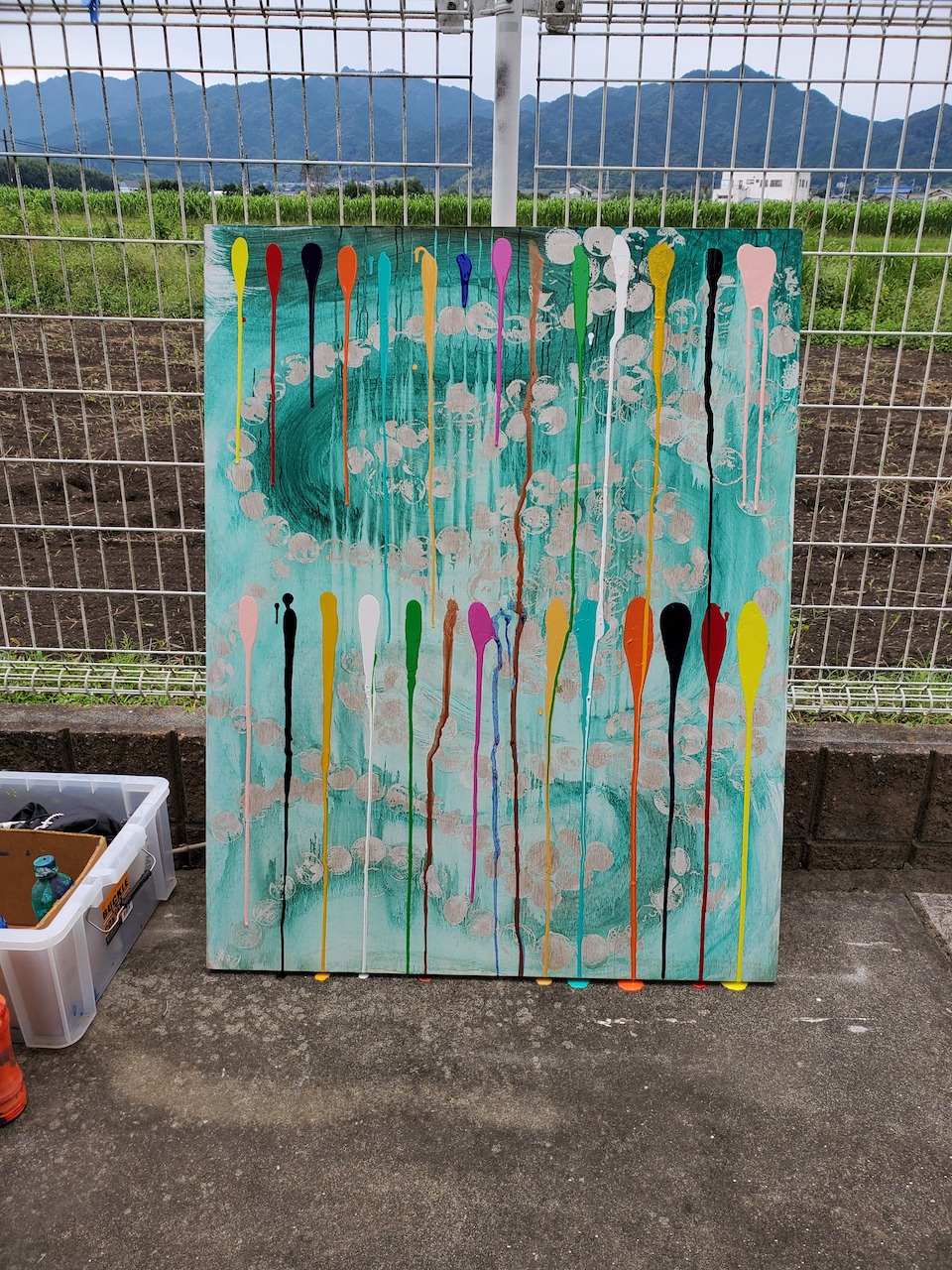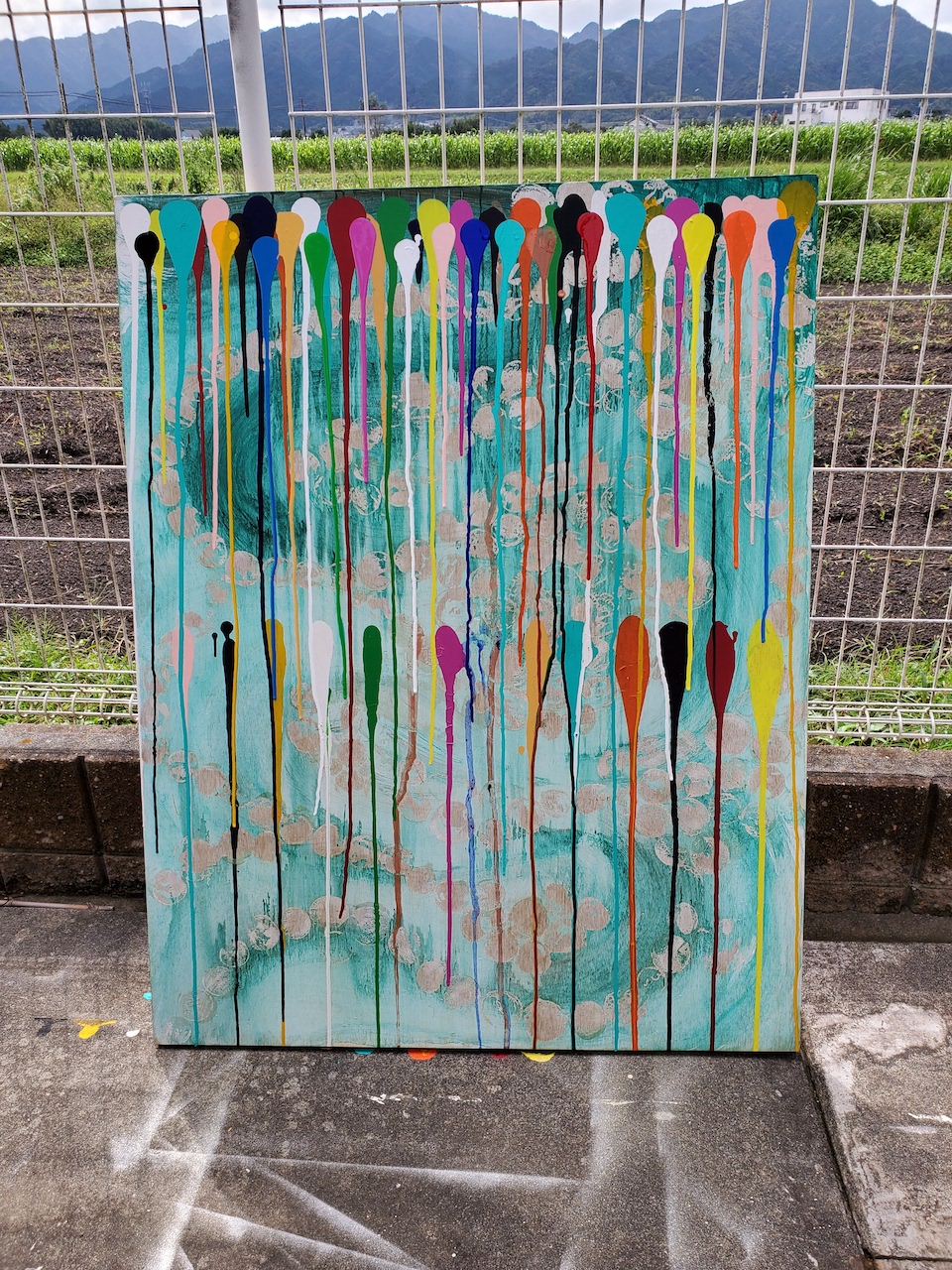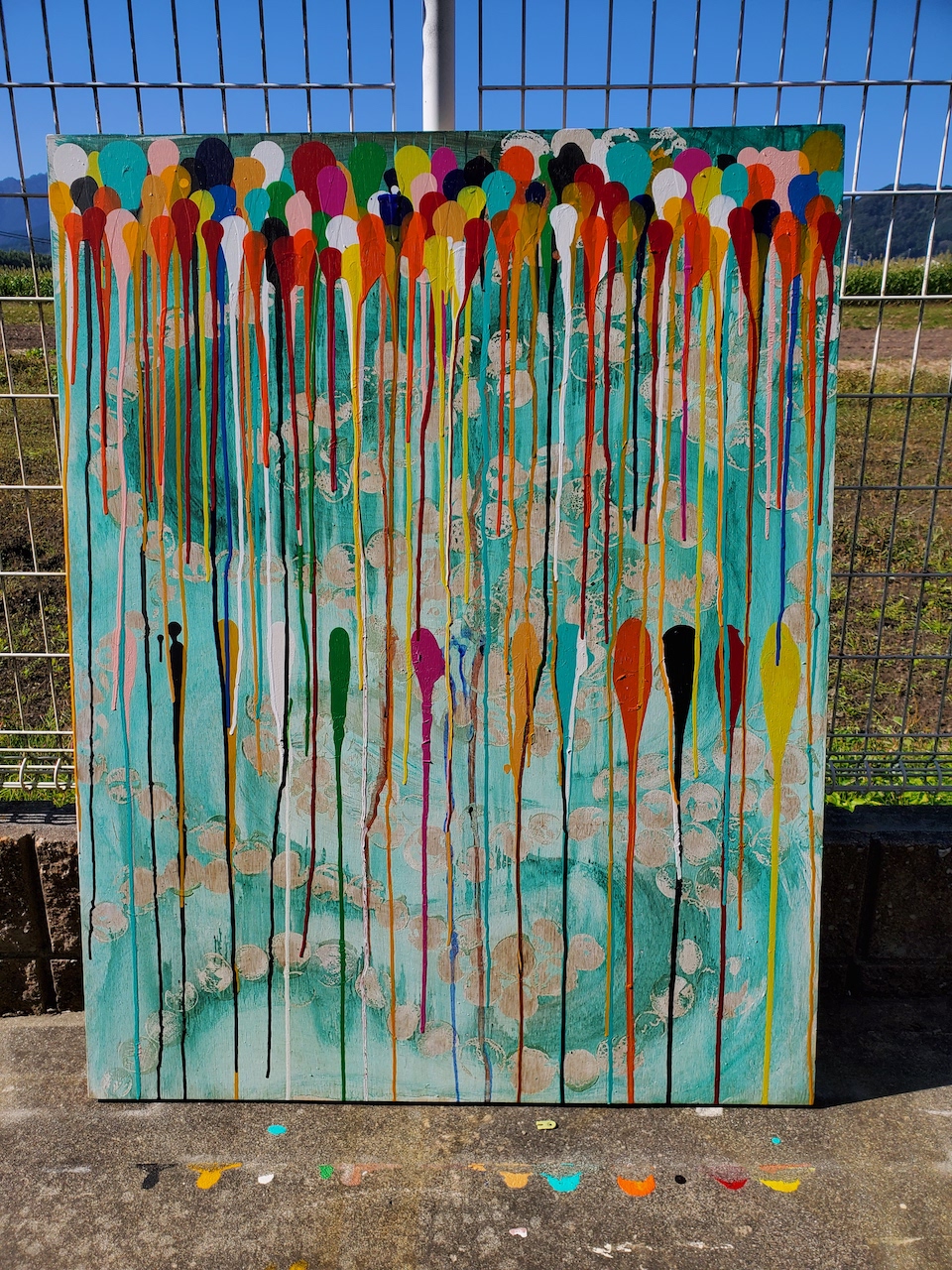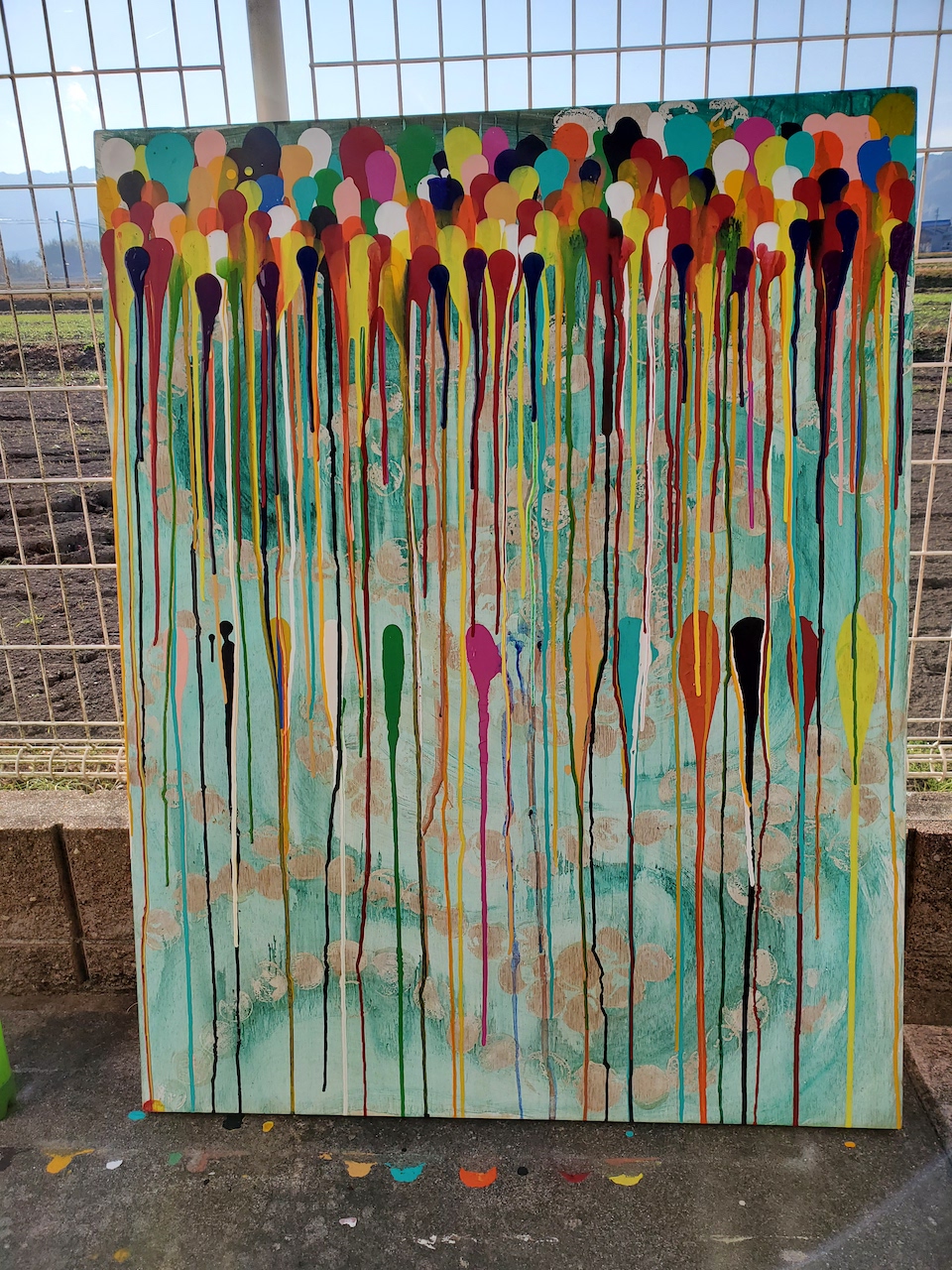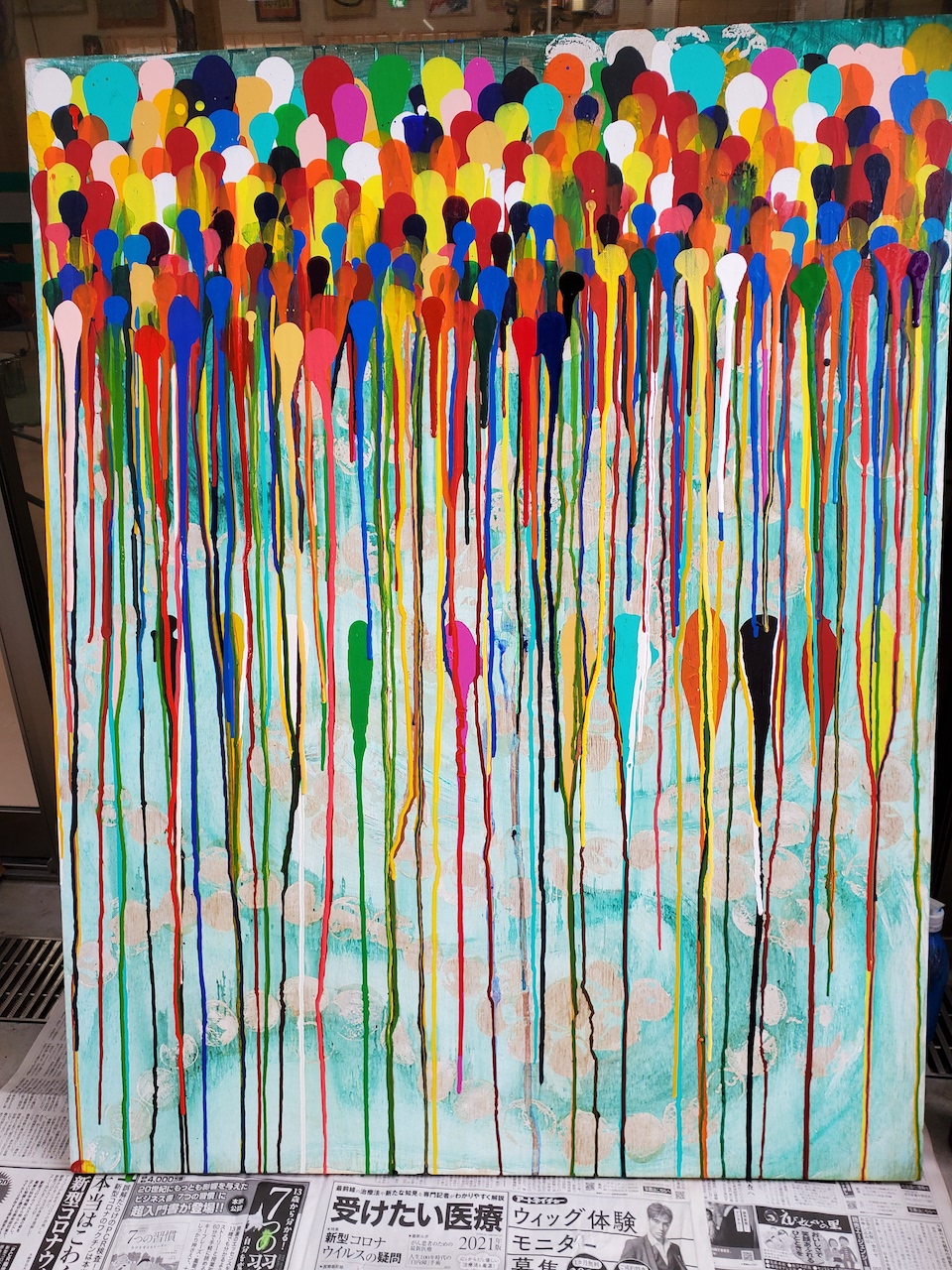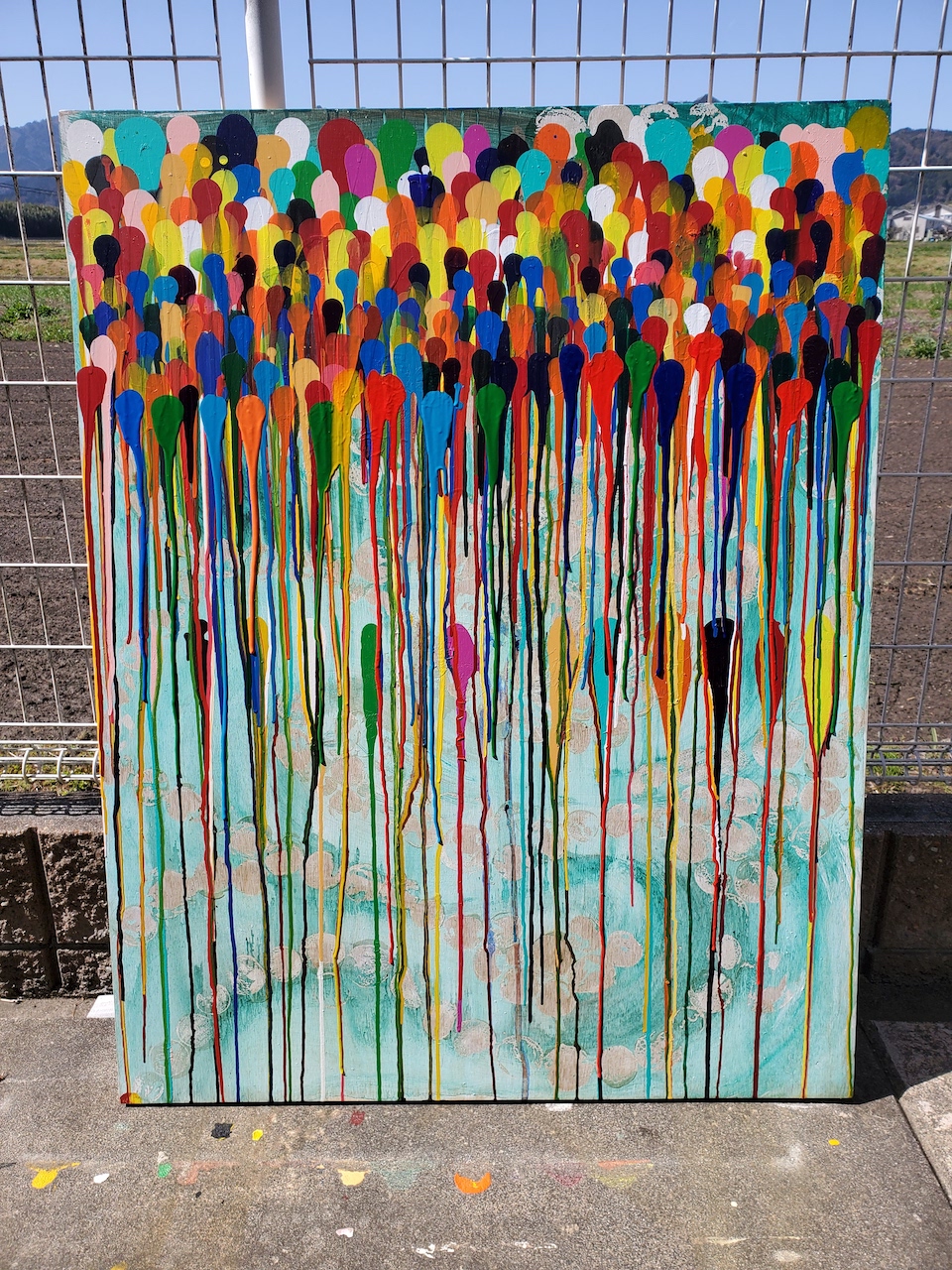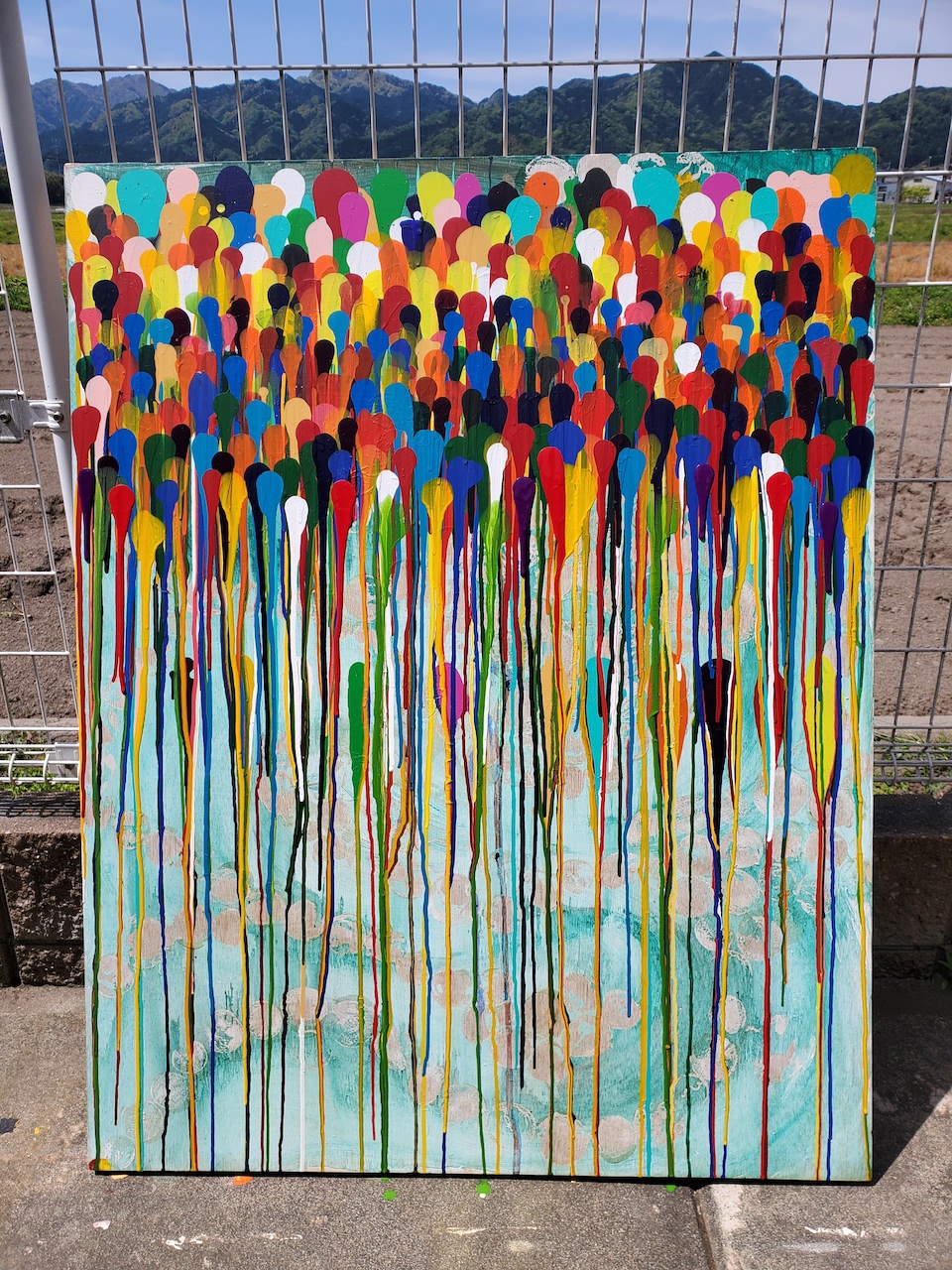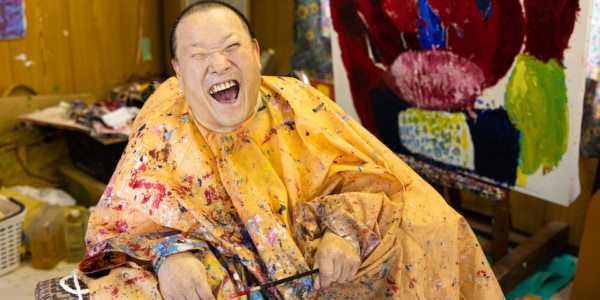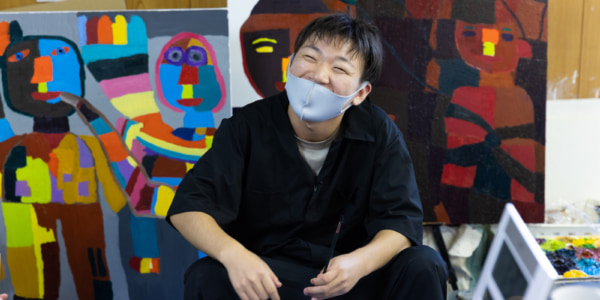Inventing an art style that works for his body
Susuki Masahito’s arms and legs move involuntarily. Because of this, he normally has them secured to his wheelchair. The only part of his body he can move voluntarily is from the neck up. Because of speech impairment, talking is difficult for him. He has no problems, however, hearing what people say to him. Susuki conveys words using a headband with a pointer attached and pointing at letters on a specially-created board.
This device, nicknamed the “anglerfish”, was custom-created by a mentor Susuki met while in junior high school.
The layout of the “anglerfish” has been updated every so often to make it easier to use. In addition to the Japanese syllabary, frequently-used words are printed on the board such as “yes,” “no,” “when,” “I made a mistake,” “tell me,” “toilet,” and “what do you think?” The device is stowed on one side of Susuki’s wheelchair so it can be brought out at any time.
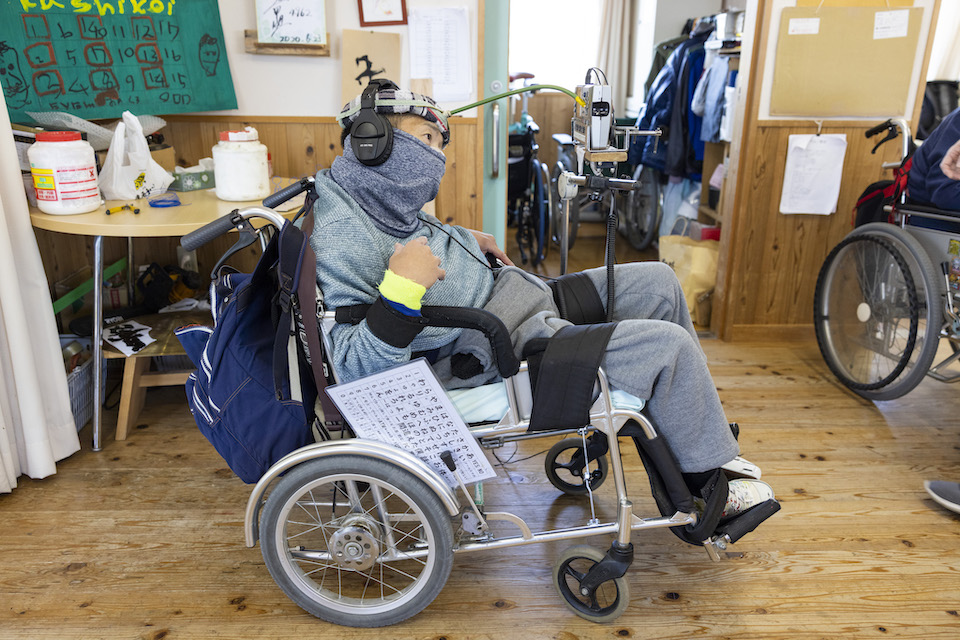
Susuki’s usual spot at the〈Garden of Hope〉. Susuki’s normal style is to have his letterboard stowed on one side and his backpack in back of his wheelchair. He wears sneakers he painted himself on his feet.
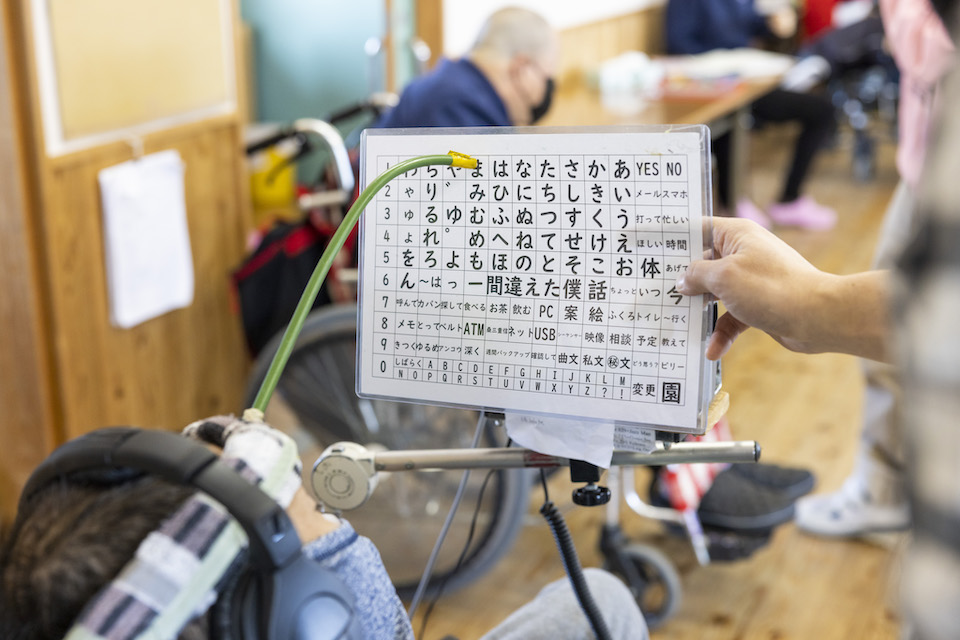
When engaging in conversation, his conversation partner will adjust the angle, distance, and position of the pointer and letterboard, intuiting what works for Susuki. I wonder what the meaning of the “secret phrase” square is?
Susuki has been painting since his school days by holding a brush in his mouth. After graduating high school, Susuki began utilizing the 〈Garden of Hope〉, and it is there he came up with new ways of making art.
First, he began covering the wheels of his electric wheelchair with paint to drive over a canvas.
Next, he came up with a dynamic style by covering his whole body with paint and lying on a canvas to allow his involuntary movements to create a picture.
Currently, Susuki uses beverage bottles filled with paints to create his works.
These bottles are hung together over a canvas and tied to Susuki’s wrists with string. When Susuki’s involuntary movements cause the strings to be pulled on, the bottles shake and drip paint from holes in their caps. Everything is Susuki’s own idea and is implemented through discussion with staff members.
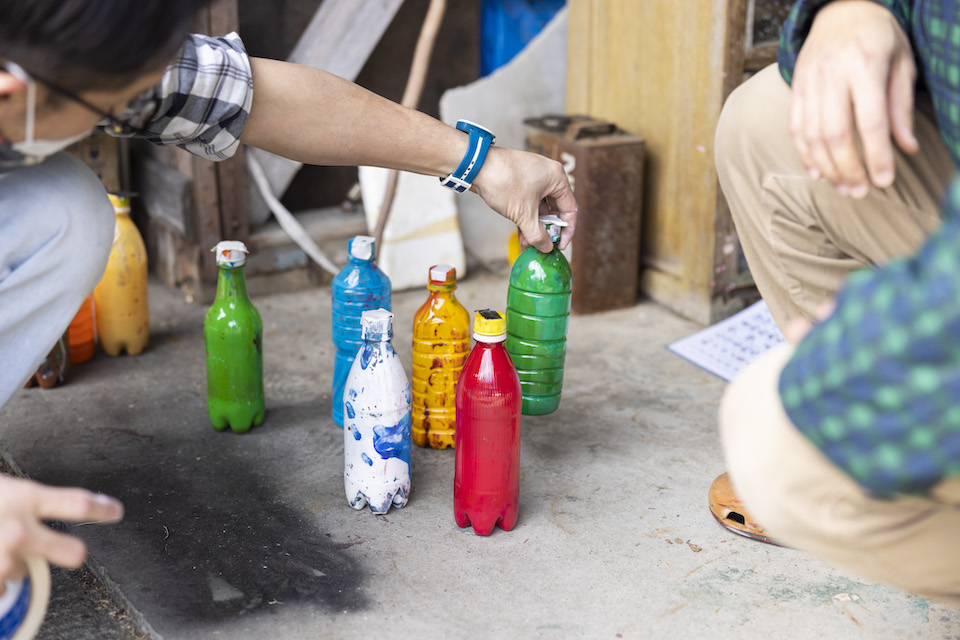
Staff members Nakamura and Mikami put paints into beverage bottles to prepare for Susuki’s art-making process.
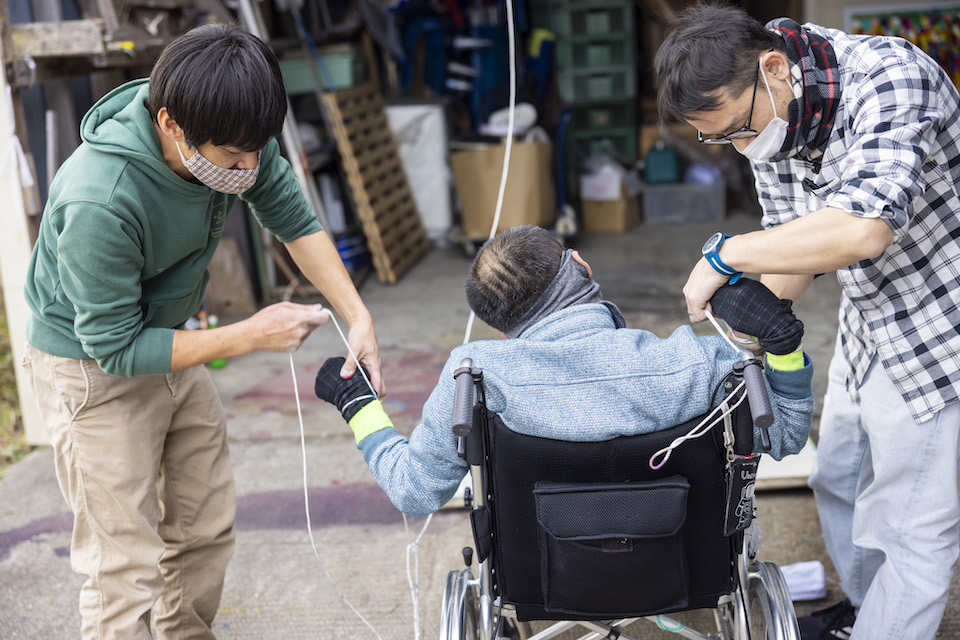
Through his letterboard, expressions, and head nods, Garden of Hope staff communicate with Susuki and identify his intentions down to the last detail, supporting his artistic activities.
On the day I visited, Susuki demonstrated how he is using beverage bottles to create his works. Using the anglerfish, Susuki tells staff he wants to start with the light colors. His arms move, abruptly pulling on the strings again and again, causing a rain of paint to splash down from above.
The paints have a high moisture content, and their brilliant colors collide with each other, mix, and flow. During the session, one of the bottles accidentally falls onto the canvas, and the entire process, including this event, is recorded on the medium’s surface.
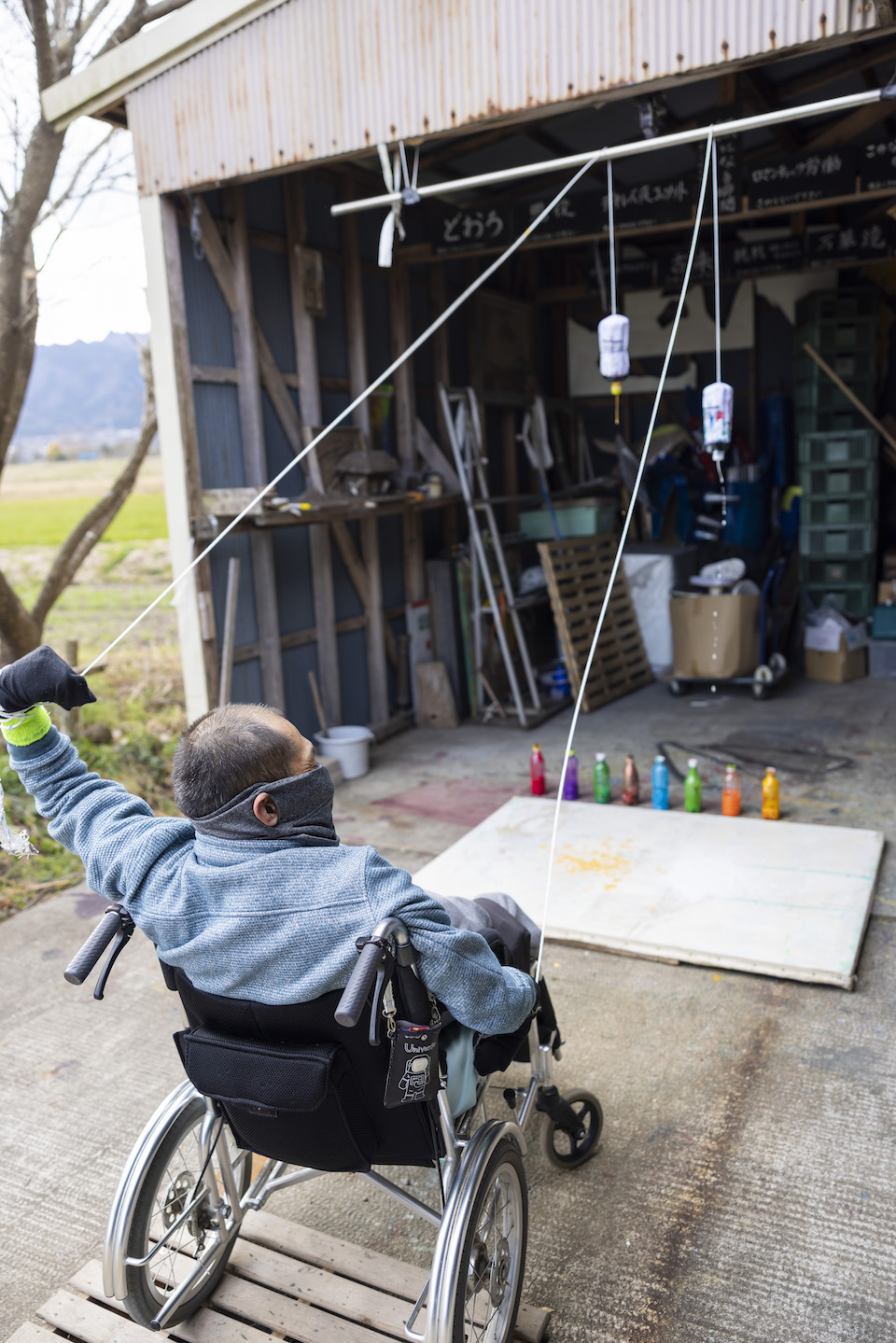
With his arms moving in great sweeps, the suspended beverage bottles shake and rain paints below. Susuki invented this style of painting.
After he is finished painting, I ask Susuki what he is thinking when he makes his art. After a small silence, he points at characters on his letterboard one by one, answering my question.
“B-E-C-A-U-S-E I-T M-O-V-E-S O-N I-T-S O-W-N.” “Ah, because your body moves of its own accord,” I confirm, and Susuki nods yes.
“I-M N-O-T T-H-I-N-K-I-N-G A-N-Y-T-H-I-N-G.” “Because my body moves on its own, I’m not thinking anything.”
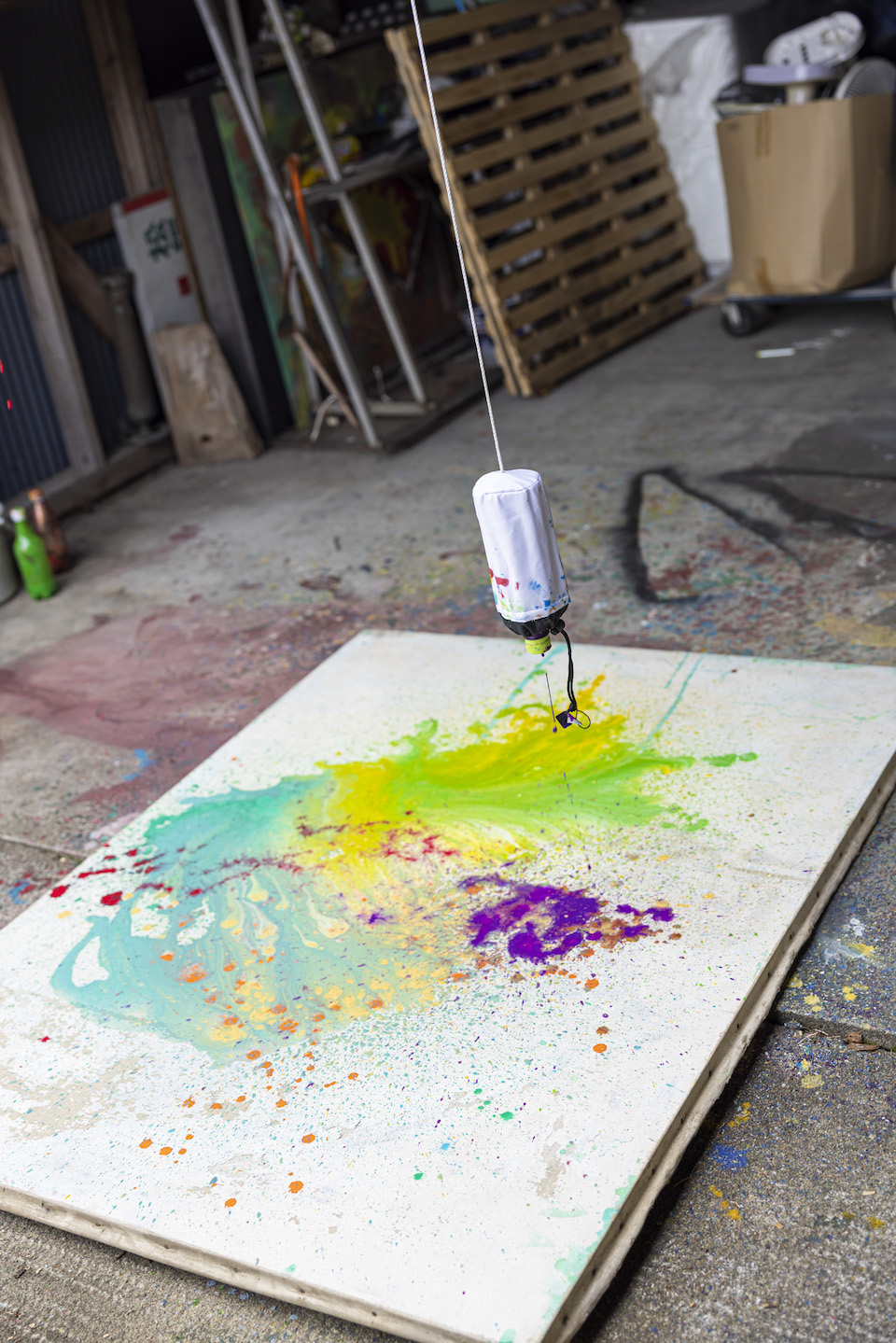
A work in progress. Director at the〈Garden of Hope〉, MURABAYSHI Shinya, talked with me about Susuki’s works, including this entire process.
Next, I asked Susuki how he felt when he saw the completed piece. Susuki points at characters spelling out “I see.”
MIKAMI Masashi, one of the staff members who help Susuki in his creative activities, clarifies for me. “I believe what he means is that Susuki himself doesn’t even know what he will make. Seeing the resulting phenomenon, he thinks to himself, ‘so this is what came out of that.’”
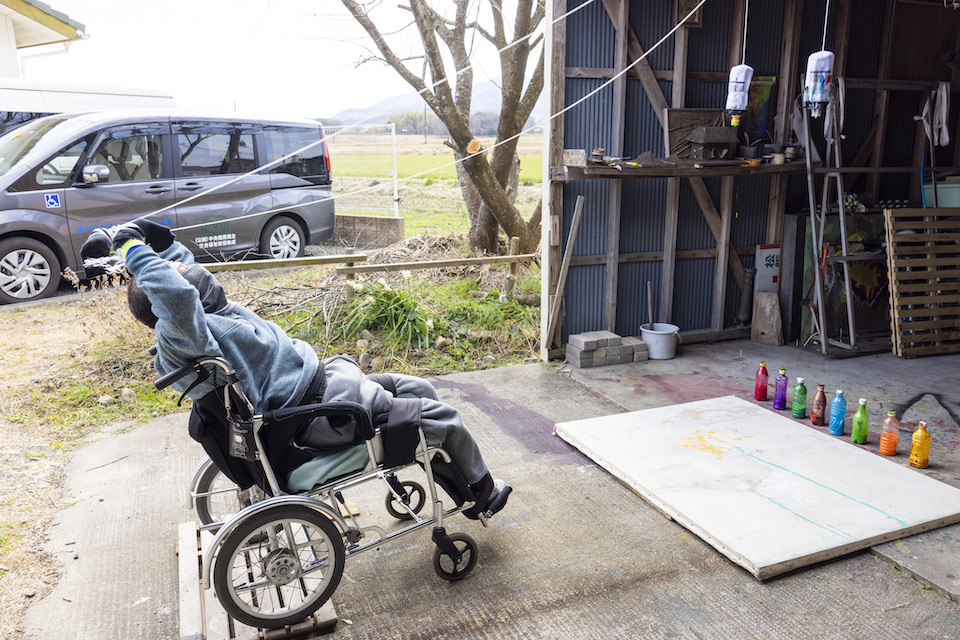
Susuki in the middle of painting a piece. Paints rain down on the canvas with splashing sounds.
Director at the〈Garden of Hope〉, MURABAYASHI Shinya mentions the composers John Cage and Erik Satie. As if creating a musical score through painting, the spontaneous movements of his body result in the creation of works of art using the tools of canvas and paint.
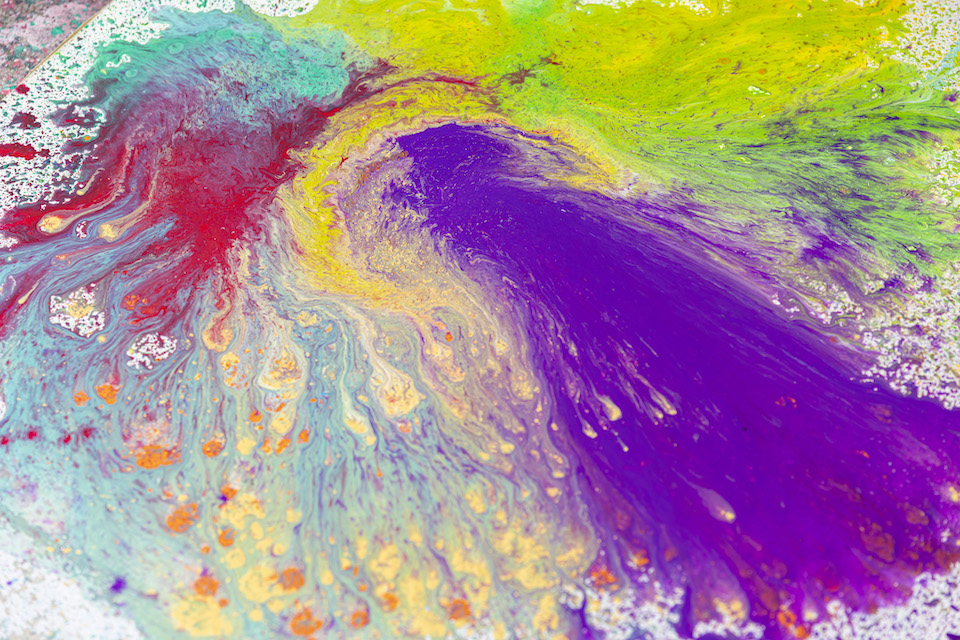
A completed piece. Susuki’s paints, containing a high moisture content, continuously sway, shake, and change form across the canvas.
Expanding what is possible
In addition to painting, Susuki also creates music. Susuki uses his anglerfish to operate buttons on a sequencer, producing ambient songs. When performing on stage, Susuki has paintings he has created projected on a screen, filling the space with a world of his own creations.
Susuki began making music around 2003. To start, Susuki formed a band with Murabayashi, other Garden of Hope members, and another staff member, and was in charge of the drum machine. When they played, there would be times where a specific phrase needed to be played. Susuki, however, was sometimes too late or early, or played the wrong sounds.
Murabayashi told me, “There were just some times when Susuki couldn’t play on que. It caused him a lot of conflict. So he thought about what to do. He couldn’t do this, that, or this, but he could do this. So he thought about how he could use that and build on and develop it. He truly is an artist to the core.”
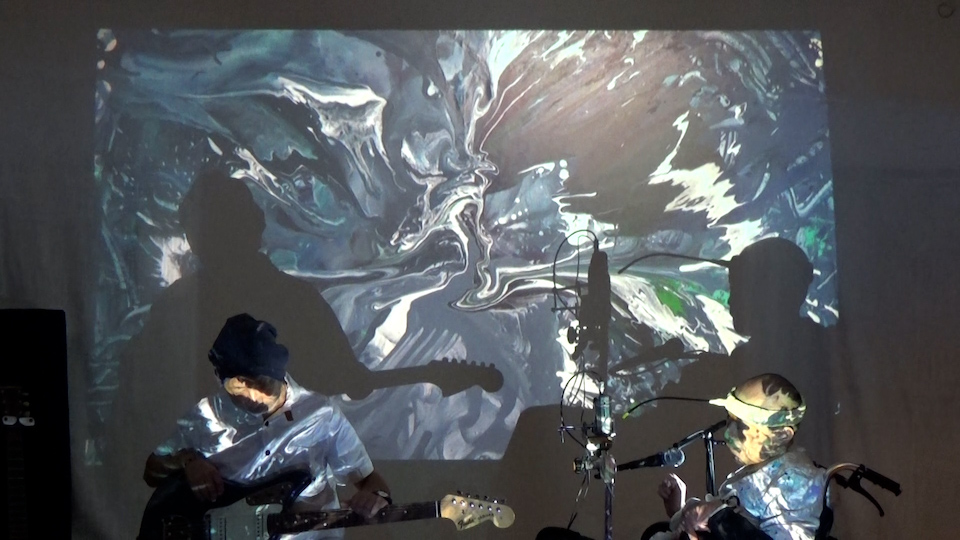
Susuki and Murabayashi playing on stage together at the〈Garden of Hope〉. The event was aired in November 2011 on the Garden of Hope’s live YouTube program, “Mie Prefecture Art Brut & Music Brut.” Photo by: Garden of Hope
This in turn resulted in the creation of Susuki’s solo unit “Fukuro.” This is the Japanese word for “bag” and I was told it expresses Susuki’s powerful will that if he “really wanted to, he could envelope the world whole.”
When I asked him about his music, Susuki told me, “T-H-E S-O-N-G-S A-R-E M-Y C-H-I-L-D-R-E-N.” In place of the artist himself, his songs are introducing more and more people to his world.
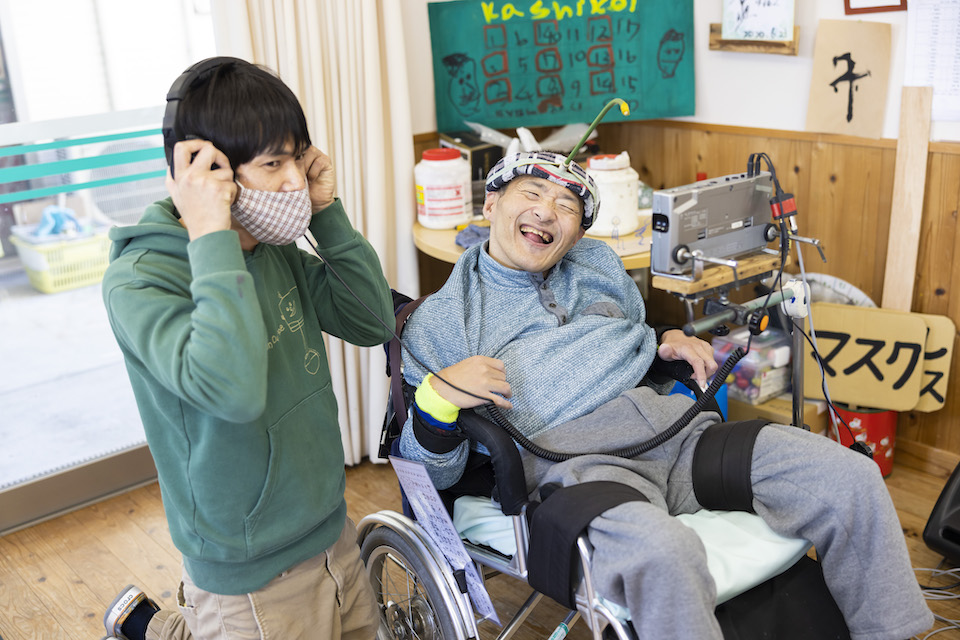
Staff member Mikami checking the music with Susuki.
When Susuki visits a new place, he requires a family member, helper, or Garden of Hope staff member to go along with him. He then builds relationships with the people who work at the banks and stores there, eventually enabling him to go there alone. Expressing his intent via his letterboard, Susuki works with employees at these locations to accomplish what he needs to do.
For example, he has become close with two employees at a Mister Donut location. They take Susuki’s order using his letterboard and take his wallet out of his bag for him to pay for his purchase. They have even come to help him eat and use the bathroom.
One day, Susuki went to Mister Donut, but it had closed down. However, Susuki had the opportunity to learn what happened to the two employees he had befriended. Both of them have decided to work in social welfare because of their contact with Susuki.
Susuki is an activist who changes people’s lives and society. When a new park was built in the area, Susuki joined the local citizens’ council, and when city hall was being rebuilt, the city asked him about their plans to employ universal design principles. Susuki has continuously thought about the role he can play, having been born with the body he has. From love to boat racing, he also doesn’t neglect the things he likes.
“Because of his body, he requires people to help him. He doesn’t want to be discriminated against. He also doesn’t want people to pity him. He wants to establish himself as-is, as he is, in society. That’s what he’s always done,” says Murabayashi.
Susuki introduces his life and the nature of his body to people. Fully utilizing who he is now, he is making waves as an artist and as a social activist. Susuki’s way of life itself is social sculpture. Today, Susuki continues to expand the scope in which he and the people he knows live in.
“Won’t you look at my life and smile?”
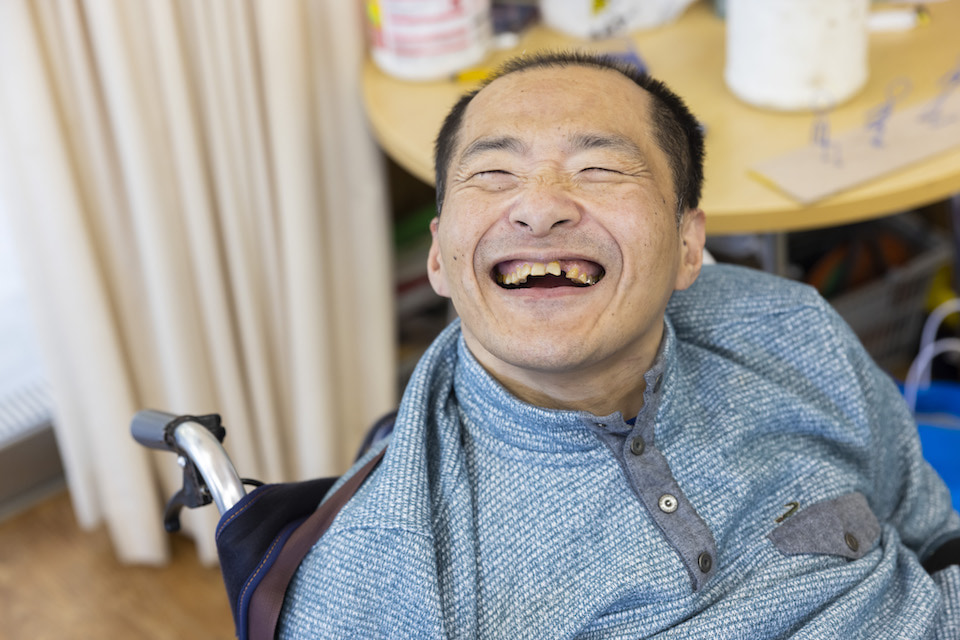
When we talked about things Susuki liked, he showed me an especially big smile.
Information
〈Garden of Hope〉Official website




